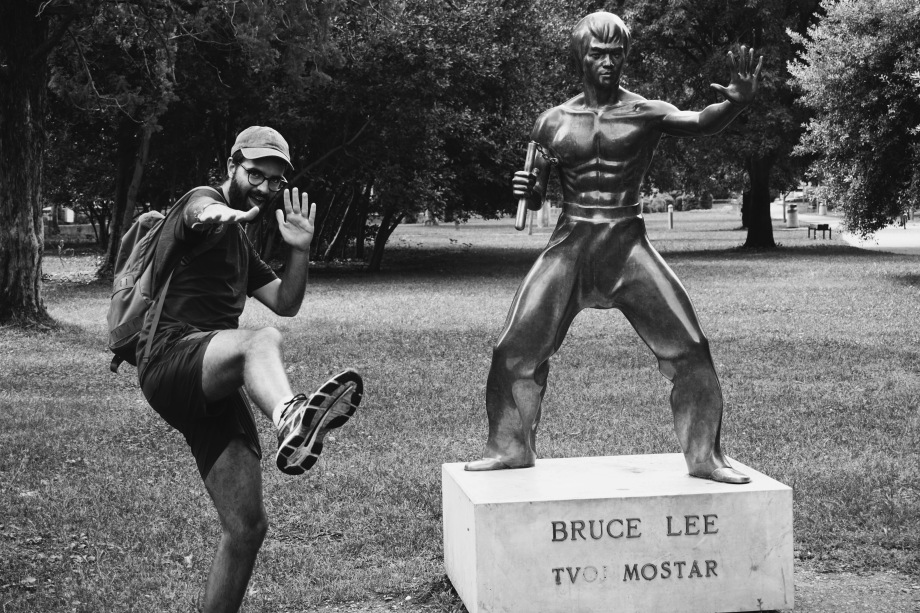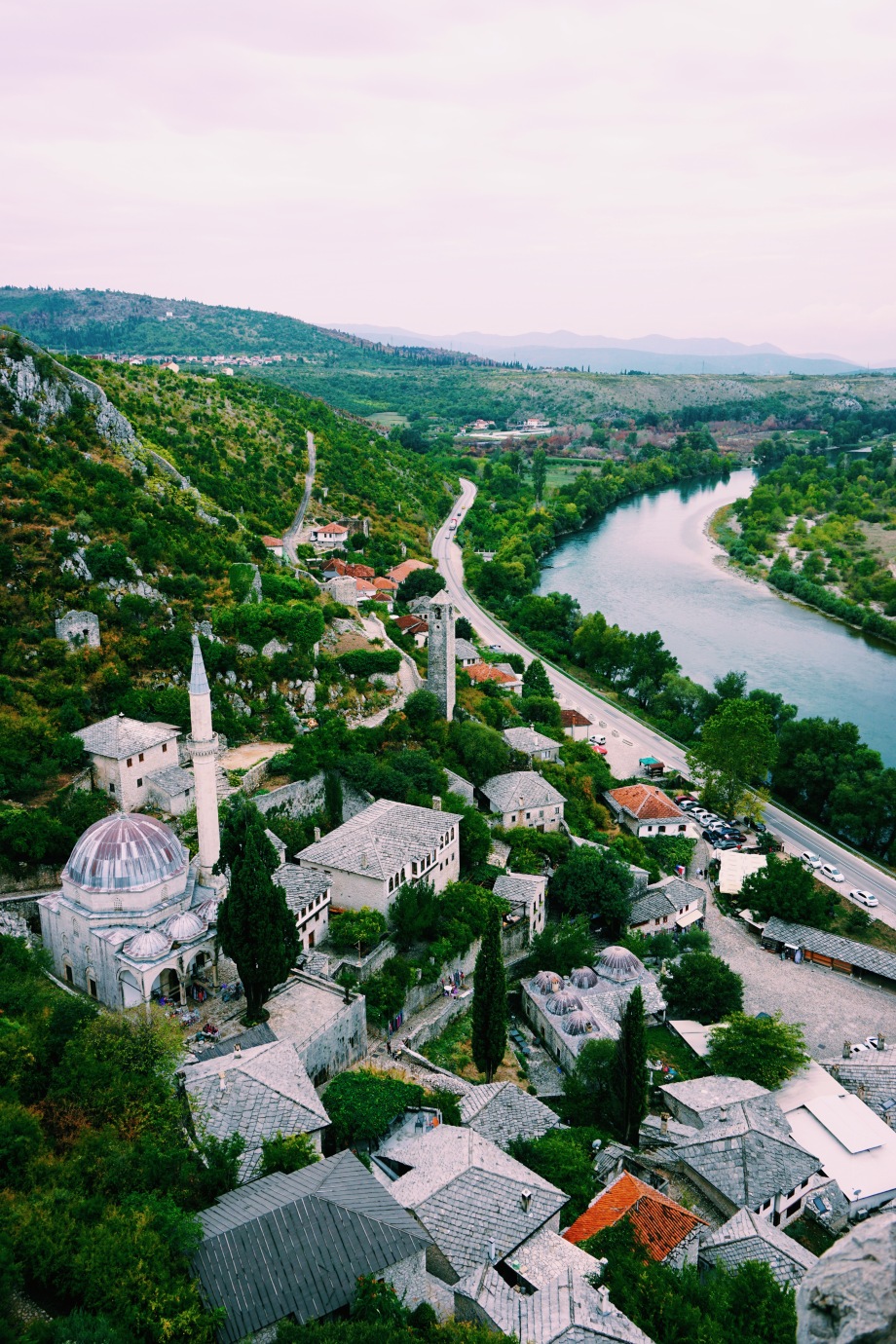Crossing the border into Bosnia & Herzegovina, our first stop was the popular town of Mostar, situated on the turquoise Neretva River.
Bosnia & Herzegovina is truly a fascinating country, with incredible cuisine, kind-natured people, and some spectacular landscapes. However, the impact of the war remains evident throughout the country, despite the conflict concluding over two decades ago. For us, being more familiar with World War I and II, the recency of the Bosnian War was disconcerting. Being Gen Y’s, it hit home that we could have lived through this tragedy, indeed many young people we met lived through this war and shared vivid stories with us.
Mostar
Mostar is located within the Herzegovina region and is a lively city inhabited by both Croats and Bosniaks. One only has to walk through the čaršija (market) to get a sense of the Ottoman influence on local culture, with many local businesses selling everything from immaculate handmade goods to cheap imitation souvenirs! Perhaps the most infamous landmark in the town is the iconic Stari Most (old bridge), a 16th century bridge constructed by the Ottomans. Popular amongst daredevil divers, the 24m high bridge is now a part of the Red Bull Cliff Diving tour, but unfortunately no one was game to jump during our visit!
After walking over the impressive Stari Most, we decided to visit the Koskin-Mehmed Pasha Mosque and climb the incredibly narrow and winding stairway to the top of the minaret. The position and height of the minaret provides arguably the best view of the Stari Most and Neretva River running through the town! The mosque itself is also finely decorated, and was an interesting juxtaposition to the North African mosques we had previously encountered in Morocco.
A short walk out of the old town took us to the Park Zrinjevac, a spacious and green park popular with locals and tourists alike. The reason for our visit was to check out an odd landmark in this city – a statue of Bruce Lee!! The story goes that the statue was constructed as a symbol against ethnic divisions in the city, with Bruce Lee selected as the symbol because he is universally adored! Hard to argue with that logic!

Next to Park Zrinjevac is an abandoned building that used to house a bank in the 1990’s. From the outside this building does not look noteworthy, however it was utilised as a Sniper Tower by the Croats/Serbs (at different points of the war) during the Bosnian conflict. This fact has attracted many tourists to the abandoned tower, despite being illegal due to the buildings current condition. Legalities aside, if you wish, you can enter the building at the rear by jumping over a wall! We decided to risk it and explore the 8 storey building, which was full of thought-provoking graffiti; art amongst the shattered glass and piles of rubbish.
After a lengthy day exploring Mostar, we accidentally discovered what we would classify the best Čevapi in the Balkans so far! Čevapi is a skinless sausage served with bread, raw onion and ajvar (capsicum and vegetable relish common in the Balkans). This claim was corroborated by a number of locals and our tour guide the next day, so we were grateful to have visited Tima-Irma – a must do in Mostar!

Tour of Herzegovina
To ensure we were able to experience more of Herzegovina than just the city of Mostar, we booked a Herzegovina region tour with iHouse Travel. To our surprise, we were, again, the only two on the tour! Our guide Dario gave us an in depth explanation of the regions history and detail on the recent conflicts, amongst many anecdotes on life in Bosnia.
Our first stop was Tekija Blagaj, a monastery built during the Ottoman’s reign over this region in the 16th century. The monastery is also known as the Dervish House, and was actively utilised by the Dervish until 1925. Set under a steep cliff face and next to an incredibly clear spring, the monastery makes for a perfect day trip from Mostar! Tourist tip: the best photos can be taken from the other side of the river. Walk behind the cafes and restaurants on the opposite side and you will find a great lookout point!
Our next stop was the Pocitelj, a small fortified village dating back to the 16th century. This village is significant as it was only partially damaged during the Bosnian War, and as such is one of the most well preserved villages within the country. To best view the entire village, we recommend taking the short 20 minute hike to the fortress that stands at the summit of the town. From here you can ascend yet another narrow, winding staircase to reach the highest tower! On our way to Pocitelj, we also stopped at Zitomislic Monastery, a picturesque orthodox church that has a lengthy history – being completely destroyed and rebuilt twice in the last 80 years.

Our final stop was the Kravica Waterfall, a 25m high waterfall which you can swim right next to! Owing to the ominous thunderstorm, we forewent the opportunity for a swim and instead settled for a late lunch by the water. This was the perfect way to end our tour of the Herzegovina region! Tourist tip: if you are going to have a swim beware of water snakes. Although we did not see any, our guide informed us that they are regularly encountered by unsuspecting tourists!
Until next time,
AP & DT


























Whats a coincidence, I wrote about Bosnia and Herzegovina today! I love this country and Mostar, plus surrounded area. It is absolutely amazing! Greetings guys 🙂
LikeLiked by 1 person
We absolutely loved Mostar and Bosnia in general, such an amazing country despite the past! 🙂 we will read your post!
LikeLiked by 1 person
Oh my. I visited these places before the war. Every year we travelled by train from Slovenia via Sarajevo to the sea along the Neretva river and it was gorgeous. Hearing of the destruction and of tourists visiting sniper nests makes my skin crawl. However it certainly makes for an eye-opener. It could have been everybody.
LikeLike